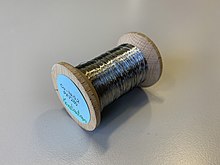Constantan
| Constantan | |
|---|---|
 A spool of Constantan wire | |
| Material type | Copper-nickel alloy |
| Physical properties | |
| Density(ρ) | 8885 kg/m3 |
| Mechanical properties | |
| Young's modulus(E) | 162 GPa |
| Tensile strength(σt) | ~450 MPa |
| Elongation(ε)atbreak | ~0.25% |
| Thermal properties | |
| Melting temperature(Tm) | 1210 °C |
| Electrical properties | |
| Surfaceresistivity | 0.56 μΩ·m |
Constantan,also known in various contexts as Eureka, Advance, and Ferry, refers to a copper-nickel alloy commonly used for its stable electrical resistance across a wide range of temperatures.[1]It usually consists of 55% copper and 45% nickel.[2]Its main feature is the low thermal variation of itsresistivity,which is constant over a wide range of temperatures. Otheralloyswith similarly lowtemperature coefficientsare known, such asmanganin(Cu [86%] / Mn [12%] / Ni [2%] ).
History
[edit]In 1887,Edward Westondiscovered that metals can have a negative temperature coefficient of resistance, inventing what he called his "Alloy No. 2." It was produced inGermanywhere it was renamed "Konstantan".[3][4]
Constantan alloy
[edit]Of all alloys used in modernstrain gauges,constantan is the oldest, and still the most widely used. This situation reflects the fact that constantan has the best overall combination of properties needed for many strain gauge applications. This alloy has, for example, an adequately highstrainsensitivity, orgauge factor,which is relatively insensitive to strain level andtemperature.Itsresistivity(5.00×10−7Ω·m)[2]is high enough to achieve suitable resistance values in even very small grids, and itstemperature coefficientofresistanceis fairly low. In addition, constantan is characterized by a goodfatigue lifeand relatively highelongationcapability. However, constantan tends to exhibit a continuous drift at temperatures above 65 °C (149 °F);[5]and this characteristic should be taken into account whenzerostability of the strain gauge is critical over a period of hours or days. Constantan is also used for electrical resistance heating andthermocouples.[6]
A-alloy
[edit]Very importantly, constantan can be processed for self-temperature compensation to match a wide range of test materialcoefficients of thermal expansion.A-alloy is supplied in self-temperature-compensation (S-T-C) numbers 00, 03, 05, 06, 09, 13, 15, 18, 30, 40, and 50, for use on test materials with corresponding thermal expansion coefficients, expressed in parts per million by length (or μm/m) per degrees Fahrenheit.
P alloy
[edit]For themeasurementof very large strains, 5% (50,000microstrain) or above, annealed constantan (P alloy) is the grid material normally selected. Constantan in this form is veryductile;and, in gauge lengths of 0.125 inches (3.2 mm) and longer, can be strained to >20%. It should be borne in mind, however, that under high cyclic strains the P alloy will exhibit some permanent resistivity change with each cycle, and cause a correspondingzeroshift in the strain gauge. Because of this characteristic and the tendency for premature grid failure with repeated straining, P alloy is not ordinarily recommended for cyclic strain applications. P alloy is available with S-T-C numbers of 08 and 40 for use onmetalsandplastics,respectively.
Physical properties
[edit]| Property | Value |
|---|---|
| Electrical resistivity at room temperature[2] | 5.00×10−7Ω·m |
| Temperature coefficientat20 °C[7] | 8 ppm·K−1 |
| Temperature coefficient−55 to 105 °C[2] | ±40 ppm·K−1 |
| Curie point[8] | 35 K |
| Density[2] | 8.9 × 103kg/m3 |
| Melting point | 1221–1300 °C |
| Specific heat capacity | 390 J/(kg·K) |
| Thermal conductivityat23 °C | 19.5 W/(m·K) |
| Linearcoefficient of thermal expansionat25 to 105 °C[2] | 14.9×10−6K−1 |
| Tensile strength[2] | 455–860 MPa |
| Elongation at fracture | <45% |
| Elastic modulus | 162 GPa |
Temperature measurement
[edit]Constantan is also used to formthermocoupleswith wires made ofiron,copper, orchromel.[6]It has an extraordinarily strong negativeSeebeck coefficientabove 0 degrees Celsius,[9]leading to a good temperature sensitivity.
References
[edit]- ^M. A. Laughton; D. F. Warne (2003).Electrical Engineers Reference Book(16th ed.). Elsevier. p. 10/43.ISBN0-7506-4637-3.
- ^abcdefgJ. R. Davis (2001).Copper and Copper Alloys.ASM International. p. 158.ISBN0-87170-726-8.
- ^A chronological history of electrical development from 600 B.C.National Electrical Manufacturers Association. 1946. p. 59.
- ^D. O. Woodbury (1949).A measure for greatness: a short biography of Edward Weston.McGraw-Hill. p. 168.
- ^Hannah, R.L. (1992).Strain Gage Users' Handbook.New York: Springer. p. 50.ISBN978-0412537202.
- ^ab"Working with Chromel, Alumel & Constantan".Keats Manufacturing Co.2015-03-12.Retrieved2016-05-18.
- ^J. O'Malley (1992).Schaum's outline of theory and problems of basic circuit analysis.McGraw-Hill Professional. p.19.ISBN0-07-047824-4.
- ^Varanasi, C. V.; Brunke, L.; Burke, J.; Maartense, I.; Padmaja, N.; Efstathiadis, H.; Chaney, A.; Barnes, P. N. (2006). "Biaxially textured constantan alloy (Cu 55 wt%, Ni 44 wt%, Mn 1 wt%) substrates for YBa2Cu3O7−x coated conductors".Superconductor Science and Technology.19(9): 896.Bibcode:2006SuScT..19..896V.doi:10.1088/0953-2048/19/9/002.S2CID119007573.
- ^Handbook of Temperature Measurement Vol. 3, edited by Robin E. Bentley
Bibliography
[edit]- J. R. Davis (2001).Copper and Copper Alloys.ASM International.ISBN0-87170-726-8.
